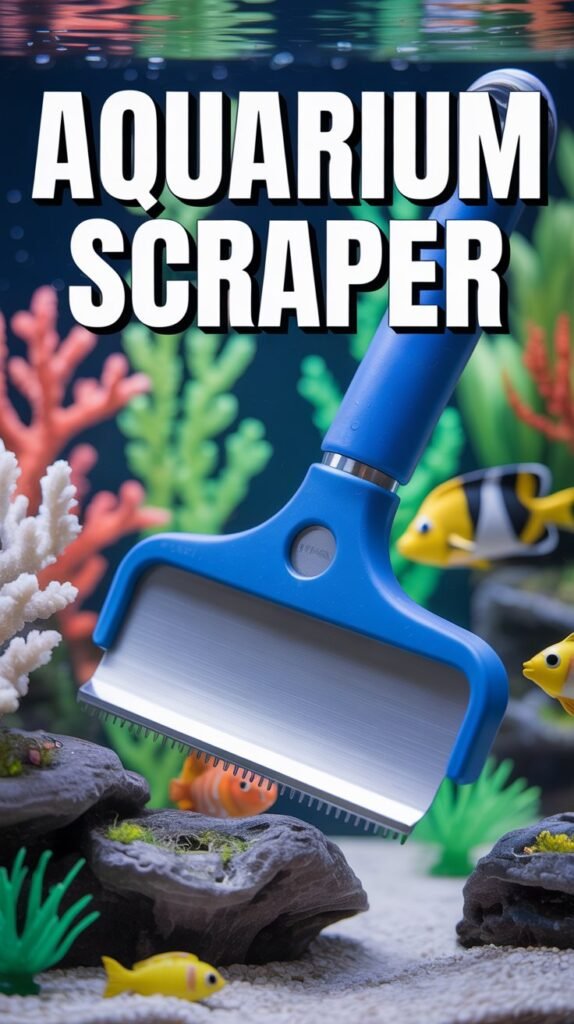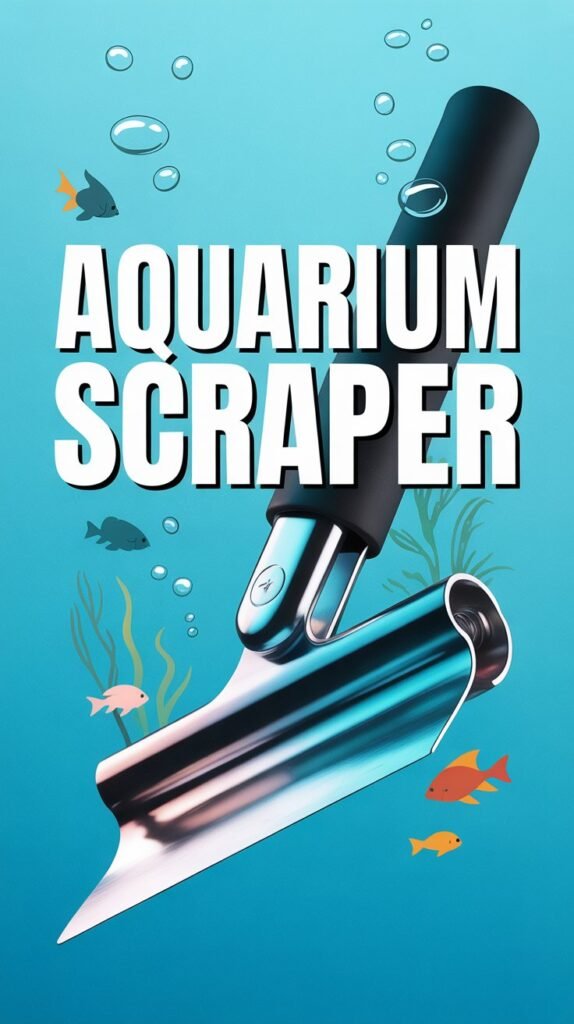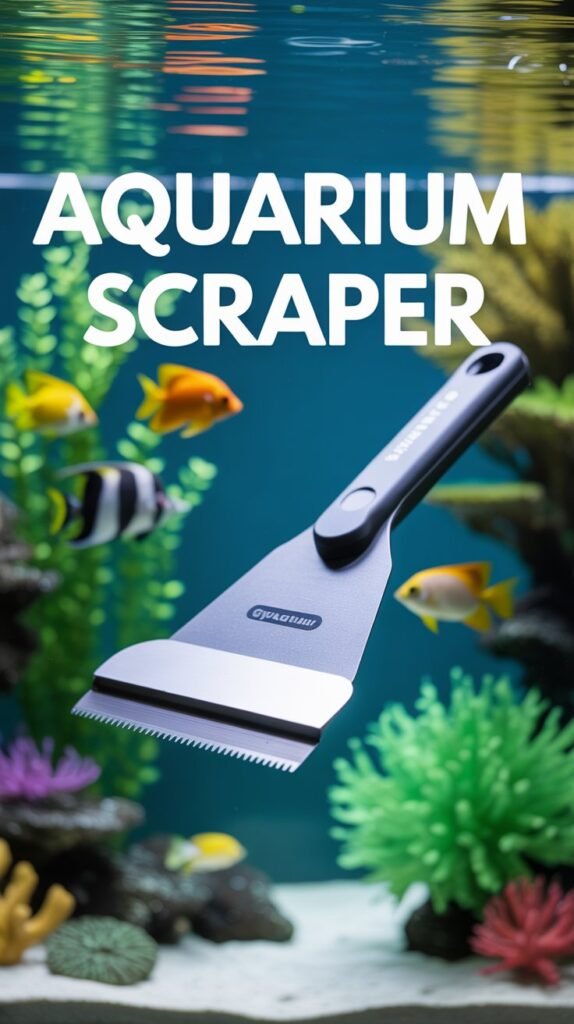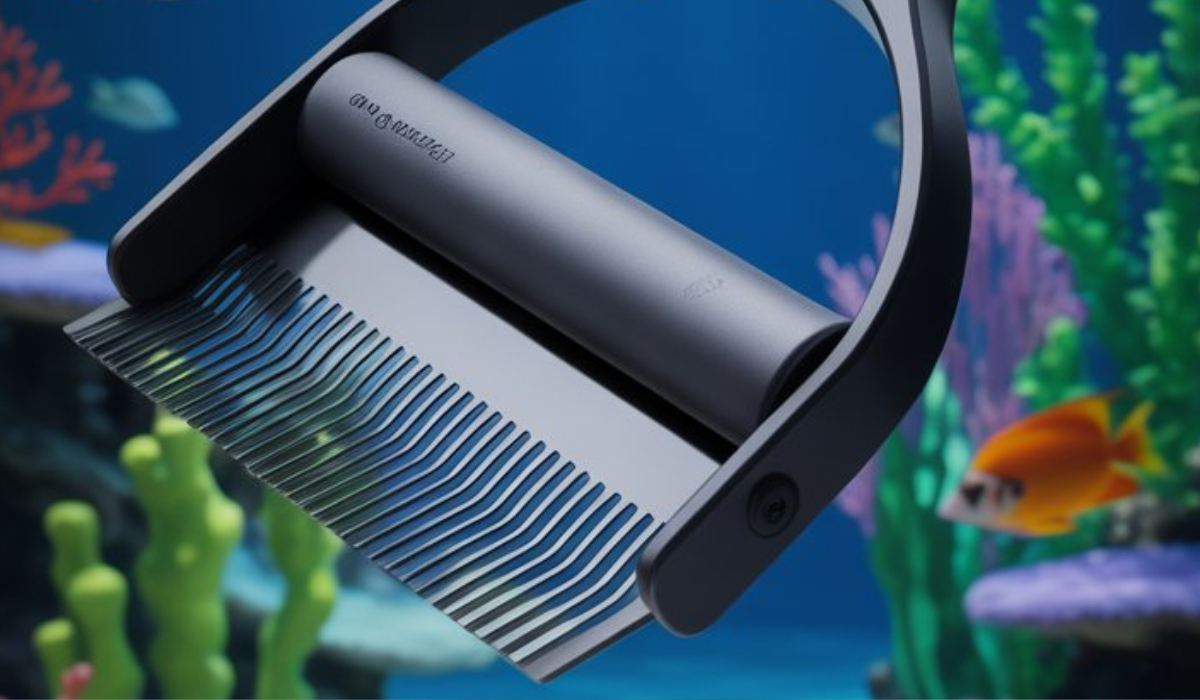A sparkling, algae-free aquarium not only enhances your tank’s beauty but also provides a healthier environment for fish and plants. However, keeping aquarium glass clean is not as simple as it looks — algae, mineral deposits, and biofilm can quickly accumulate. That’s where an aquarium scraper becomes essential.
Whether you maintain a small freshwater setup or a large marine reef tank, the right scraper saves you time, effort, and frustration. In this comprehensive guide, you’ll learn everything about aquarium scrapers — their types, uses, benefits, cleaning techniques, and how to choose the best one for your tank.
What Is an Aquarium Scraper?
An aquarium scraper is a cleaning tool specifically designed to remove algae, calcium deposits, and grime from aquarium glass or acrylic walls. It ensures a clear view of your aquatic environment without scratching or damaging the tank’s surface.
Unlike household sponges or cloths, aquarium scrapers are made from fish-safe materials and designed to reach every corner of your tank easily. Some are manual, while others use magnets or even robotic systems for effortless cleaning.
Why Do You Need an Aquarium Scraper?

Even with the best filtration and lighting balance, algae and film growth are inevitable in aquariums. Over time, they make the glass cloudy and unattractive. Here’s why an aquarium scraper is essential:
- Maintains Crystal Clear Visibility
Algae buildup can distort your view. Regular scraping keeps the glass spotless. - Promotes Better Light Penetration
Clean glass allows more light to reach plants and corals, supporting healthy growth. - Prevents Stubborn Deposits
Regular scraping prevents thick algae and mineral buildup, which are harder to remove later. - Safe for Fish and Plants
Aquarium scrapers are designed to avoid introducing toxins or residues from household cleaning tools. - Saves Time and Effort
Specialized scrapers reach corners and deep spots easily, reducing manual scrubbing.
Types of Aquarium Scrapers
There’s no one-size-fits-all scraper — the right one depends on your tank type, glass material, and personal preference. Let’s explore the main types available.
1. Manual Scrapers
Manual scrapers are simple handheld tools with a scraping blade or pad. They require manual effort but provide excellent control and precision.
Features:
- Typically made from plastic, stainless steel, or rubber
- Ideal for small tanks or spot cleaning
- Available in various handle lengths
Pros:
- Affordable
- Easy to use
- Safe for both glass and acrylic (with proper blade type)
Cons:
- Requires arm reach and effort
- Hard to use in deep tanks
Best For:
Small freshwater aquariums or beginner hobbyists.
2. Magnetic Scrapers
Magnetic scrapers use two magnetized parts — one inside the aquarium and one outside. When you move the external magnet, the inner scraper follows, cleaning algae off the glass without wetting your hands.
Features:
- Magnetic strength matched to glass thickness
- Various pad materials for different tank types
Pros:
- Hands stay dry
- Easy to use for daily cleaning
- Efficient for large tanks
Cons:
- May trap sand or gravel, causing scratches
- Not ideal for thick algae buildup
Best For:
Medium to large aquariums and hobbyists who prefer hands-free maintenance.
3. Long-Handled Scrapers
These scrapers feature extendable or fixed long handles, ideal for deep tanks or hard-to-reach corners. The head often includes interchangeable blades or pads.
Features:
- Adjustable handle lengths
- Safe for both glass and acrylic
- Ergonomic grips for comfort
Pros:
- Keeps hands dry
- Great for tall or wide aquariums
- Provides leverage and control
Cons:
- Bulky for small tanks
- Blades may need frequent replacement
Best For:
Deep aquariums, planted tanks, or large display setups.
4. Razor Blade Scrapers

These scrapers use metal razor blades to remove hard algae or mineral deposits effectively. They’re powerful but must be used with caution to avoid scratching.
Features:
- Stainless steel or plastic blades
- Replaceable blade system
- Some models are magnetic or handheld
Pros:
- Removes stubborn algae and lime scale
- Works quickly and effectively
Cons:
- Can scratch acrylic surfaces
- Blades dull over time
Best For:
Glass aquariums with tough algae buildup.
5. Plastic Blade Scrapers
Plastic blades are a safe alternative for acrylic tanks, which scratch easily. They gently lift algae without damaging the surface.
Pros:
- Scratch-resistant
- Lightweight
- Ideal for sensitive surfaces
Cons:
- Less effective on hard deposits
- Blades wear out faster
Best For:
Acrylic aquariums and beginner aquarists.
6. Magnetic Floating Scrapers
These innovative scrapers float if the magnetic connection breaks, preventing them from sinking to the bottom. This feature avoids sand contact and makes retrieval easy.
Pros:
- User-friendly
- Safe for glass
- No risk of trapping sand
Cons:
- Slightly more expensive
Best For:
Large glass aquariums and reef setups.
7. Electric or Robotic Scrapers
The newest addition to aquarium cleaning, automatic scrapers, use motorized blades or pads to clean the glass automatically.
Pros:
- Fully automated cleaning
- Ideal for large display tanks
Cons:
- Expensive
- Requires charging or power source
Best For:
Public aquariums or professional setups.
Choosing the Right Aquarium Scraper

Selecting the right scraper depends on multiple factors — let’s go through them:
1. Tank Material
- Glass Aquarium: Use stainless steel or metal razor scrapers.
- Acrylic Aquarium: Always use plastic blades or soft pads to prevent scratches.
2. Tank Size and Depth
- Small tanks: Handheld or magnetic scrapers.
- Large/deep tanks: Long-handled or extendable scrapers.
3. Algae Type
- Soft algae: Use pads or plastic blades.
- Hard green or coraline algae: Use metal blades.
4. Safety
Ensure the scraper materials are aquarium-safe and rust-resistant. Avoid tools with chemical coatings.
5. Comfort and Grip
Choose a scraper with an ergonomic handle and anti-slip grip for comfortable use during long cleaning sessions.
6. Budget
Manual scrapers cost as little as $5, while advanced magnetic or robotic models can range from $30 to $150+.
Top Aquarium Scrapers (2025 Recommendations)
Here are some top-rated models used by aquarists worldwide:
| Brand/Model | Type | Tank Type | Key Features |
|---|---|---|---|
| Flipper Cleaner | Magnetic | Glass/Acrylic | Dual-sided magnetic, floating design |
| Aqueon Pro Scraper | Long-handled | Glass | Replaceable blades, ergonomic grip |
| API Algae Scraper | Manual | Acrylic | Safe plastic blade for delicate tanks |
| Mag-Float | Magnetic Floating | Glass | Easy retrieval, anti-scratch pads |
| Kent Marine Pro-Scraper II | Metal Blade | Glass | Interchangeable blades for heavy algae |
These scrapers are durable, efficient, and suited for both beginners and professionals.
How to Use an Aquarium Scraper (Step-by-Step Guide)
Using an aquarium scraper correctly ensures a clean tank without harming fish or plants. Follow these steps:
Step 1: Turn Off Equipment
Switch off filters, heaters, and pumps to prevent splashing or suction interference.
Step 2: Clean from Top to Bottom
Start scraping from the top of the glass and work your way down. This prevents debris from reattaching to cleaned surfaces.
Step 3: Use Gentle Pressure
Avoid pressing too hard, especially with razor blades. Let the tool do the work to prevent scratches.
Step 4: Focus on Corners and Edges
Use a narrow scraper or sponge for tight spots where algae tend to accumulate.
Step 5: Remove Floating Debris
After scraping, use a fish net or filter intake sponge to capture floating algae particles.
Step 6: Rinse the Scraper
Always rinse your scraper in freshwater after use to prevent rust or contamination.
Maintenance Tips for Aquarium Scrapers
Proper care extends your scraper’s lifespan and keeps it effective.
- Rinse After Every Use – Prevents corrosion or mineral buildup.
- Replace Blades Regularly – Dull blades reduce efficiency.
- Store in a Dry Area – Keeps rust and bacterial growth away.
- Avoid Mixing Tools – Don’t use the same scraper in multiple tanks to prevent cross-contamination.
- Inspect for Sand Particles – Clean pads to prevent accidental glass scratches.
Homemade Aquarium Scraper (DIY Option)
If you’re on a budget or enjoy DIY, you can create your own aquarium scraper using household items.
You’ll Need:
- Old credit card or plastic spatula
- Long stick or ruler
- Rubber bands or glue
Attach the card to the stick to create a simple, effective scraper for small tanks. It’s safe for acrylic and glass alike.
Common Mistakes to Avoid When Using Aquarium Scrapers
- Using Metal Blades on Acrylic – Causes permanent scratches.
- Applying Too Much Force – Can crack thin glass or loosen seams.
- Neglecting Rinsing – Residues can harm fish.
- Cleaning During Feeding Time – Fish may get stressed or injured.
- Ignoring Regular Cleaning – The longer algae sit, the harder they become to remove.
Advantages of Using an Aquarium Scraper
- Keeps aquarium glass spotless
- Reduces algae growth
- Enhances aquarium appearance
- Prevents harmful buildup
- Increases light penetration
- Easy and safe maintenance
An aquarium scraper is one of the most essential tools for any aquarist aiming for a pristine display.
When to Use an Aquarium Scraper
You should scrape your aquarium glass once or twice a week, depending on algae growth and lighting conditions. For tanks with high light exposure, daily light cleaning helps prevent hard algae formation.
Eco-Friendly Aquarium Scrapers
With sustainability in mind, several brands now offer biodegradable or reusable scrapers. These reduce plastic waste while keeping your tank spotless. Examples include bamboo-handled scrapers or models with recyclable pads.
Can You Use Household Tools Instead of Aquarium Scrapers?
While it might seem convenient, avoid using household tools like kitchen sponges, steel wool, or window scrapers. They may:
- Contain harmful chemicals or detergents
- Scratch glass or acrylic
- Introduce toxins into the water
Always choose aquarium-safe products to ensure fish health.
How to Remove Hard Algae and Mineral Deposits
For stubborn green spot algae or lime scale, try the following:
- Use a razor scraper for glass tanks.
- For acrylic tanks, use vinegar-safe scrapers or soft plastic blades.
- Perform gentle, circular motions.
- Avoid harsh chemicals — they harm aquatic life.
Safety Precautions When Using Aquarium Scrapers
- Avoid startling fish by sudden movements.
- Never scrape near fish eggs or delicate corals.
- Keep sharp blades away from children.
- Check magnets before use to prevent trapped gravel scratches.
Conclusion
An aquarium scraper is one of the simplest yet most valuable tools for aquarium maintenance. Whether you use a magnetic cleaner, long-handled scraper, or razor blade, regular cleaning ensures a clear, healthy, and beautiful aquatic display.
By choosing the right scraper for your tank type and following proper maintenance, you’ll enjoy unobstructed views of your underwater world and support the overall well-being of your aquarium inhabitants.
FAQs About Aquarium Scrapers
1. What is the best aquarium scraper for glass tanks?
The Flipper Cleaner or Kent Marine Pro-Scraper II are excellent for glass tanks due to their strong blades and dual-function design.
2. Can I use a razor blade on an acrylic aquarium?
No. Razor blades can scratch acrylic. Always use plastic blades or pads designed for acrylic tanks.
3. How often should I clean my aquarium glass?
Clean the glass once or twice a week to prevent algae buildup and maintain clarity.
4. Are magnetic scrapers safe for all tanks?
Yes, but make sure the magnetic strength matches your tank’s glass thickness and avoid trapping sand between pads.
5. What causes algae buildup on aquarium glass?
Excess nutrients, long lighting hours, and poor maintenance contribute to algae growth.
6. Can I make my own aquarium scraper?
Yes. A DIY scraper can be made from a plastic card and a stick — ideal for small tanks.
7. Do I need to remove fish before scraping?
No, but move slowly to avoid scaring or injuring them during cleaning.
8. Are electric or robotic scrapers worth it?
They’re convenient for large tanks and public aquariums, though costly for casual hobbyists.
9. Can vinegar help clean aquarium glass?
Yes, vinegar safely removes calcium deposits when used outside the tank or in small, controlled doses.
10. What’s the safest scraper for beginners?
A magnetic floating scraper is beginner-friendly and minimizes the risk of scratches or damage.

